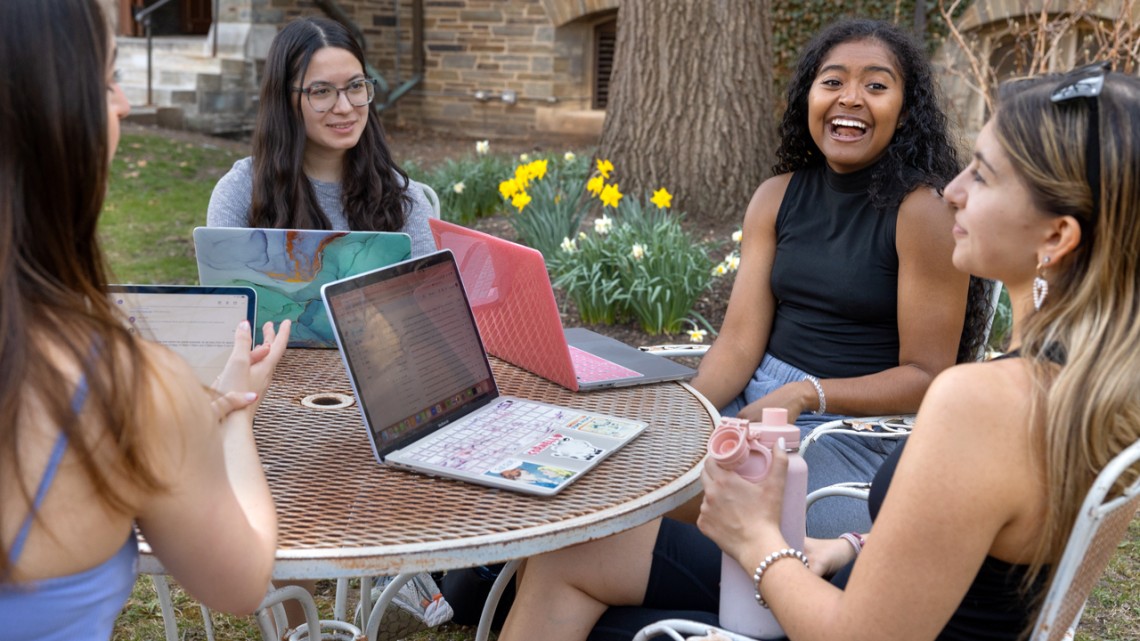
Cornell University Diversity Admissions Ambassadors executive board members (from left): Sofia van Mierlo ’24, Emily Segal ’24, Sylver Garcia ’24, and Alexandra Alexandrou ’24.
Diversity ambassadors share, connect with prospective students
By Caitlin Hayes, Cornell Chronicle
As a high school senior in Mississippi, Sylver Garcia ’24 received an email that changed her life.
The message was from a student group – Cornell University Diversity Admissions Ambassadors (CU DAA), then called CU IMAGE – encouraging her to learn more about Cornell and inviting her to talk with current students. She accepted.
“Without this organization, I wouldn’t be at Cornell today,” said Garcia, an American studies major in the College of Arts and Sciences (A&S) and student life coordinator for CU DAA. “I was able to talk to students, and they were so warm and welcoming. Compared with other schools I was looking at, the campus culture felt very different – the students had a common familial bond and really supported one another.”
CU DAA’s mission is to help historically underrepresented groups learn about, apply to and thrive at Cornell. Throughout the year, the group of approximately 25 students meets with large cohorts of high school students visiting campus through their schools or community-based groups. Ambassadors also staff panels and student office hours for the Undergraduate Admissions Office, run text and email campaigns, and collaborate with other groups to support underrepresented students on campus.
The group plans and hosts multiple events for admitted students in April each year, including virtual small group sessions and a student panel, and will be available to meet admitted students at the upcoming Cornell Days, April 22, 23, 29 and 30.
“We really give a personalized perspective on the student experience,” said Alexandra Alexandrou ‘24, vice president of CU DAA and a biological sciences major in the College of Agriculture and Life Sciences. “Because of our age and because we were admitted students not that long ago, we can connect with students on a different level that really speaks to them and answers their questions.”
“When it comes from a current student, the [prospective] students understand,” said Richard Onyejuruwa, senior assistant director of undergraduate admissions and diversity outreach and CU DAA co-adviser, with Nicole Arshad, assistant director of diversity outreach. “What the students bring to the table, literally no one else can. If we want people to understand what Cornell is really about, the only way to do that is through the eyes and words of our students.”
A student life team, led by Garcia, coordinates events with prospective students, and a communications team, led by Sofia van Mierlo ’24, a fine arts major in the College of Architecture, Art and Planning, manages branding and campus collaborations.
CU DAA was founded by students more than 20 years ago – and up until last year was named CU IMAGE (Cornell University Increasing Multicultural Admissions and Gains in Enrollment). Current students updated the name to better reflect the group’s broad mission and a definition of diversity that embraces multiple aspects of a student’s identity – from racial, ethnic, economic and religious diversity to those with LGBTQ+, veteran, disabled, or first-generation status, among other minority groups.
“I think we’re in a unique position because we’re so diverse as an organization,” said Emily Segal ’24, president of CU DAA and an ROTC student in the School of Industrial and Labor Relations. “We can guide people and provide more context for all of the resources that are here, so people can feel more welcome and supported before they even step on campus.”
Alexandrou said the access to information can be particularly meaningful for students from underrepresented groups, who may not have people in their schools or families with connections to Cornell or other Ivy League schools.
“I remember what it was like for me coming in – I had a million questions, and I had no idea who to ask because I didn’t know anyone who had gone to Cornell,” she said.
“I was so nervous because not only is Cornell a big university, it’s also an Ivy League institution,” Garcia said. “Coming from Mississippi, an area with low education rates and resources, I wondered if I could really make it at Cornell. These students assured me and encouraged me that I could and even matched me with students from the South and people from my major as well. It made me feel that this is the place I wanted to be.”
The group’s work also celebrates diversity in the current student body, Onyejuruwa said: “They create a bridge that allows prospective students to learn about current student experiences but also gives current students a platform to share and celebrate who they are as individuals and as a student organization.”
The ambassadors have gained communication and leadership skills through their work with CU DAA – but they said the greatest rewards are sharing their experiences to help others and the bond they’ve formed as a group.
“It’s just added to my whole experience,” Segal said, “having this group of people who are so driven and want to help better Cornell for the future.”
“It’s honestly been beautiful to see CU DAA growing and blossoming,” Garcia said. “And I just really enjoy speaking to the prospective students. I let them know that no matter where they come from or their circumstances, they can grow and thrive at Cornell. This is a place for you, where the opportunities are endless.”
Media Contact
Get Cornell news delivered right to your inbox.
Subscribe
